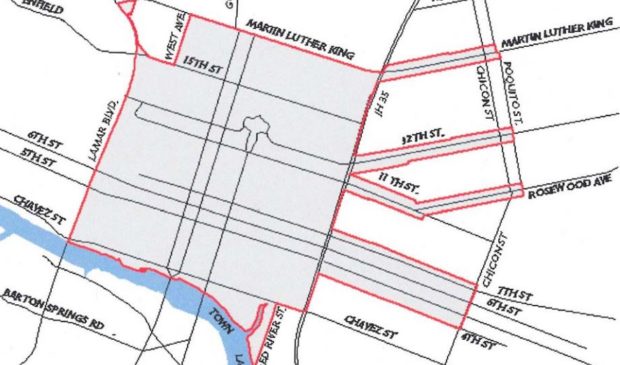Council looks to roll back CURE zoning
Wednesday, October 18, 2017 by
Jack Craver Driven by concerns over gentrification, City Council is poised to do away with the final remnants of a policy that was put in place two decades ago to encourage redevelopment downtown.
The central urban redevelopment (CURE) combining district that Council adopted in 1996 covered the entire downtown area between Lady Bird Lake, Lamar Boulevard, Martin Luther King Jr. Boulevard and Interstate 35. However, the district also included four slivers of East Austin (or “fingers”) that covered portions of East Fourth, Fifth and Sixth streets; East 12th Street; East 11th Street; and East Martin Luther King Jr. Boulevard. It allowed exemptions from some site development regulations and fees for certain redevelopment projects in the area.
In 2013, Council voted to do away with the portion of the district located downtown, but the eastern fingers remained in place.
Now, Council Member Ora Houston is sponsoring a resolution to get rid of most of the rest of CURE, describing the measure as an “emergency action” to reduce gentrification. Her measure would remove three of the four remaining CURE fingers, but leave in place the southernmost one that includes parts of East Fourth, Fifth and Sixth streets. That portion will remain at the request of Council Member Pio Renteria, who represents the area.
From Houston’s perspective, the challenge in East Austin is no longer how to encourage business investment, but rather how to slow down the flood of investment dollars that are driving up the cost of housing and forcing many longtime east siders to relocate to the outskirts of the city.
“I think those additional entitlements have a negative impact,” she said during a Council work session Tuesday. “A lot has changed since 1996.”
Houston noted that Council had moved to remove a CURE district downtown in 2013, after it became apparent that developers did not need any additional incentives to build there. Today, she argued, the same is true in near-East Austin, where construction crews are working nonstop on new luxury apartment buildings.
Most of Houston’s colleagues agreed; the typical divisions over development were notably absent.
“It’s a clear relic of a different time where the city seemed to intentionally want to push some gentrification east of I-35,” said Council Member Greg Casar. “Taking too long to address (recent gentrification) seems to have caused some real problems that people are dealing with.”
Mayor Pro Tem Kathie Tovo also chimed in, calling CURE “an idea that had a place and a time and that has passed.”
Mayor Steve Adler similarly said that he didn’t want to support additional density or height entitlements for developers unless there was a “corresponding community benefit” attached, notably affordable housing.
The only concerns that were voiced were related to process. Council Member Jimmy Flannigan wondered why the zoning change wasn’t being addressed as part of CodeNEXT, the comprehensive overhaul of the land use code that Council is aiming to adopt in April.
Planning and Zoning Department Director Greg Guernsey replied that Council could wait to include the change as part of CodeNEXT but that he had drawn up the resolution due to the “urgency” of the situation described by Houston.
Flannigan accepted this reasoning, saying that he would likely support the measure at Council’s next meeting on Thursday.
Council Member Delia Garza reiterated her concerns about neighborhood-specific rules and spot zoning, saying that the whole point of CodeNEXT is to zone from a citywide perspective.
Nevertheless, she added, “I fully support the intent of this resolution.”
Renteria also expressed concerns about the impact of CURE on his own rapidly gentrifying district. He opted not to get rid of it immediately because he wants to understand what effect such a change may have on creating affordable housing near the Plaza Saltillo development.
Map of the original CURE boundaries courtesy of the city of Austin.
The Austin Monitor’s work is made possible by donations from the community. Though our reporting covers donors from time to time, we are careful to keep business and editorial efforts separate while maintaining transparency. A complete list of donors is available here, and our code of ethics is explained here.
You're a community leader
And we’re honored you look to us for serious, in-depth news. You know a strong community needs local and dedicated watchdog reporting. We’re here for you and that won’t change. Now will you take the powerful next step and support our nonprofit news organization?



